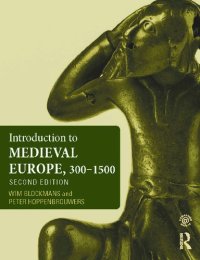
Ebook: Introduction to Medieval Europe, 300–1500
The Middle Ages as a period
in European history
Try to imagine a world in which:
■ population density at its highest level was less
than that of present-day Russia, without the
latter’s infrastructure
■ medical knowledge was appalling, which
meant that most people died young and had
to live with serious physical suffering
■ people, consequently, lived under a demographic
‘high-pressure’ regime, which means
that only by maximising fertility were they
able to keep ahead of mortality
■ there was an abundance of young people
■ infrastructure (roads, bridges) and means of
transportation were of poor quality/primitive,
so
■ few people ever travelled far – hence, geographical
scope and the mental outlook of
most people were narrow
■ economic production was overwhelmingly
agricultural
■ as a result, most people were peasants who
lived in small villages
■ technological development and mechanisation
of human labour were very limited
■ the Christian religion informed practically
every aspect of daily life
■ most people did not have any formal education,
and were unlikely to be able to read or
write.
Welcome to the Middle Ages! The Middle Ages are
not just a straightforward part of world history
taking place all over the globe. According to longaccepted
agreement among historians, adopted by
standard university curricula and standard textbooks
all over the world, the Middle Ages are a
period in Europe’s past that roughly covers the
millennium between 500 and 1500 CE. Nowadays,
the term ‘medieval’, with ‘feudal’ used as a regular
alternative, often represents something backward
and barbaric, which then is contrasted with more
splendid cultures that preceded and followed the
Middle Ages. Where did such ideas come from?
in European history
Try to imagine a world in which:
■ population density at its highest level was less
than that of present-day Russia, without the
latter’s infrastructure
■ medical knowledge was appalling, which
meant that most people died young and had
to live with serious physical suffering
■ people, consequently, lived under a demographic
‘high-pressure’ regime, which means
that only by maximising fertility were they
able to keep ahead of mortality
■ there was an abundance of young people
■ infrastructure (roads, bridges) and means of
transportation were of poor quality/primitive,
so
■ few people ever travelled far – hence, geographical
scope and the mental outlook of
most people were narrow
■ economic production was overwhelmingly
agricultural
■ as a result, most people were peasants who
lived in small villages
■ technological development and mechanisation
of human labour were very limited
■ the Christian religion informed practically
every aspect of daily life
■ most people did not have any formal education,
and were unlikely to be able to read or
write.
Welcome to the Middle Ages! The Middle Ages are
not just a straightforward part of world history
taking place all over the globe. According to longaccepted
agreement among historians, adopted by
standard university curricula and standard textbooks
all over the world, the Middle Ages are a
period in Europe’s past that roughly covers the
millennium between 500 and 1500 CE. Nowadays,
the term ‘medieval’, with ‘feudal’ used as a regular
alternative, often represents something backward
and barbaric, which then is contrasted with more
splendid cultures that preceded and followed the
Middle Ages. Where did such ideas come from?
Download the book Introduction to Medieval Europe, 300–1500 for free or read online
Continue reading on any device:

Last viewed books
Related books
{related-news}
Comments (0)